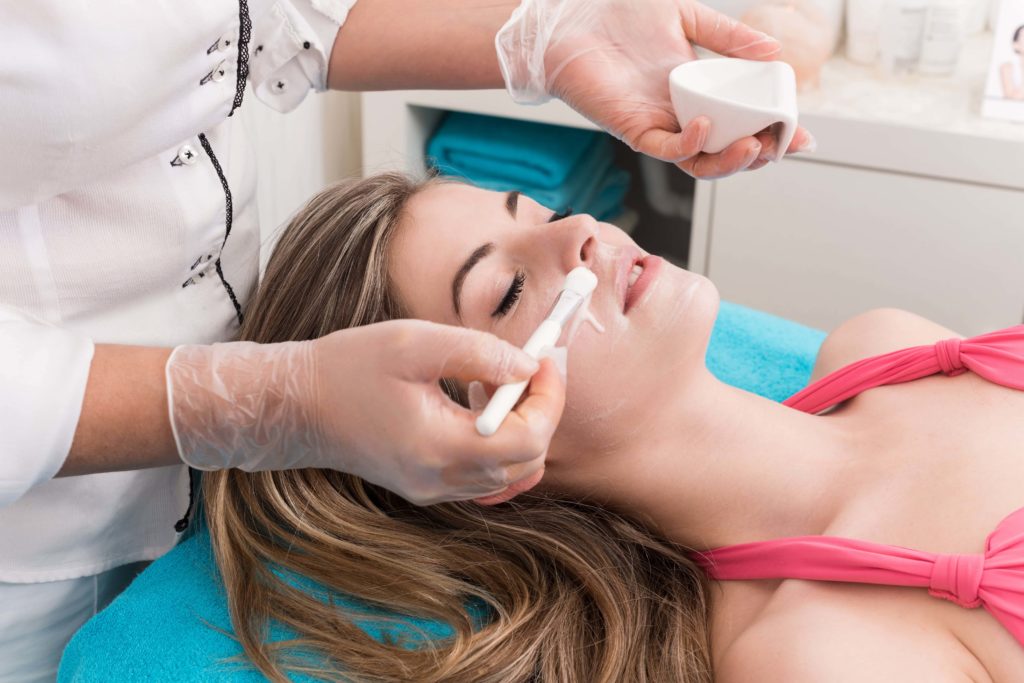Chemical peels are dermatology’s most common cosmetic treatment to help revitalize the skin. In fact, they contain a tailored chemical solution that is designed to target skin irregularities, care needs, and range in depth and intensity of treatment. The FDA has approved chemical peels for decades, and this skincare treatment has been around since the 19th century.
How Do Chemical Peels Work?
This skin resurfacing treatment uses a chemical solution to remove the outer layers of dead skin. With the process of chemical exfoliation, chemical peels can stimulate cell turnover, unclog pores, and correct skin discoloration, giving the skin a vibrant glow. The chemical solution is applied to the skin’s surface and targets the top layers to eliminate dead skin cells.
In addition, the “controlled trauma” of the chemical peel to the skin stimulates its natural peeling, improving the skin’s texture for various skin types. Chemical peels rely on different acid types, including glycolic acid, lactic acid, salicylic acid, and trichloroacetic acid (TCA). The depth and effect of the peel vary depending on the intensity and makeup of the chemical peel.
In addition, they are used today to create a customizable skin treatment that can reduce the signs of aging and revitalize irritated skin with little downtime. To be specific, chemical peels are used to:
- Eliminate the appearance of hyperpigmentation, such as melasma and age spots.
- Reduce the appearance of agings signs, such as wrinkles and fine lines.
- Get rid of acne and acne scars.
What Are The Types Of Chemical Peels?
In general, chemical peels are classified into three types based on how deep they exfoliate the skin. However, knowing the best type of chemical peel for the skin type and color should come from the advice of a board-certified dermatologist.
Superficial Peels
This peel treats skin concerns that affect the epidermis—for example, acne, rough skin texture, and mild skin discoloration. Since superficial peels do not penetrate the skin’s deeper layers, it decreases the risk of side effects and faster skin recovery. In terms of recovery, the peeling heals in 1–7 days.
During this period, protecting the skin from sun exposure is critical. An individual may require up to six sessions to achieve the desired results due to the delicate nature of superficial peels. Also, superficial peels can be received every 2-5 weeks.
Medium-depth Peels
This peel is suggested to address fine lines and wrinkles, minor hyperpigmentation, minor acne scars, and sun-damaged skin. Medium-depth peels take 7–14 days to heal. Following therapy, they produce swelling that worsens for 48 hours and may also result in blisters and scabs.
Typically, a prescription of a topical treatment to aid in the healing process is recommended by a dermatologist. During the recuperation period, it is critical to expose the skin. Further, it is recommended to notify the doctor of any history of herpes simplex infections or cold sores on the lips (face).
In addition, the dermatologist may prescribe an oral antiviral medicine to prevent the eruptions of latent cold sores. Individuals may resume wearing cosmetics after 5–7 days but must avoid prolonged sun exposure until the skin has completely healed.
Deep Peels
Dermatologists rarely conduct deep chemical peels. Laser therapy frequently produces superior outcomes regarding issues impacting the deeper layers. In some cases, a deep peel is recommended if a patient has the following conditions:
- moderate to severe sunburns
- moderate to severe wrinkles
- moderate to severe hyperpigmentation
Deep peels take 14–21 days to recover due to their intensity. A person must:
- Recuperate in the comfort of their own home.
- Take oral antiviral medication if they have a history of cold sores.
- Wash the skin with a specific solution between four and six times daily.
- Apply a healing ointment for 14 days to facilitate healing.
- For at least 14 days, refrain from wearing makeup.
- For 3–6 months, try to reduce sun exposure.
Chemical peels can help prevent further damage to the skin, giving it a more youthful or unblemished appearance. In fact, superficial peels are the least invasive and are suitable for all skin types. Since chemical peel has some downtime/recovery time, aftercare directions should be followed properly to avoid adverse effects such as redness, skin peeling, and sun sensitivity.
How To Prepare For A Chemical Peel?
Before the procedure, a consultation with the skin care specialist must be done. During this visit, they’ll help determine the best treatment option since each patient is unique. Also, they will discuss the details about the specific peel to get and ask about anything that could interfere with the peel.
This may include the acne medication that was taken and information about whether or not the patient scar easily. Here are things to remember before the chemical peel.
- Do not use any type of retinol or Retin-A topical medication for at least 48 hours.
- Inform the skin care specialist about any medications that were taken.
- Do not have been on Accutane for at least six months.
The doctor may also recommend to:
- Take an antiviral medication for any history of fever blisters or cold sores to prevent a breakout around the mouth.
- Use special lotions to improve treatment, like a glycolic acid lotion.
- Use a retinoid cream to avoid skin darkening.
- Do not use facial scrubs and exfoliants the week before the peel.
- Avoid waxing, epilating, or using depilatory hair removal products a week before the peel. Also, avoid hair bleaching.
- Arrange for a ride home, most especially for medium or deep chemical peels, since these require the patient to be sedated.
If the doctor prescribes a painkiller or sedative, take it according to their instructions; but patients are likely to take it before they come to the office.
What Are The Possible Side Effects Of Chemical Peels?
Chemical peels can have mild side effects. However, some people experience long-term negative consequences, such as:
- Months-long redness
- Dark areas of skin that are temporary
- Permanently lightened patches of skin
- Dark areas of skin that are permanent
Additionally, the best way to avoid these complications is to consult a board-certified dermatologist and carefully follow their post-treatment instructions.
Final Thoughts
Chemical peels are a perfect way to exfoliate and rejuvenate the skin as they give glowing skin by peeling off the uppermost layer of the skin with their exfoliating acids. ZI BLOOM Aesthetics offers VI Peels, which are individualized facial treatments that reveal healthier, smoother skin using chemical solutions. With the help of VI Peel treatments, the team at ZI BLOOM Aesthetics reduces skin irregularities and imperfections.


